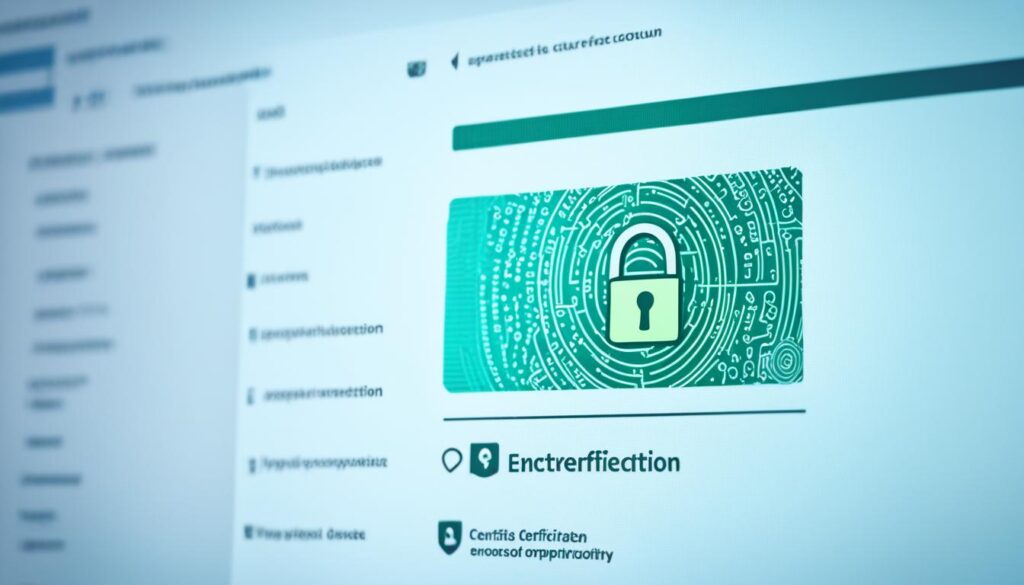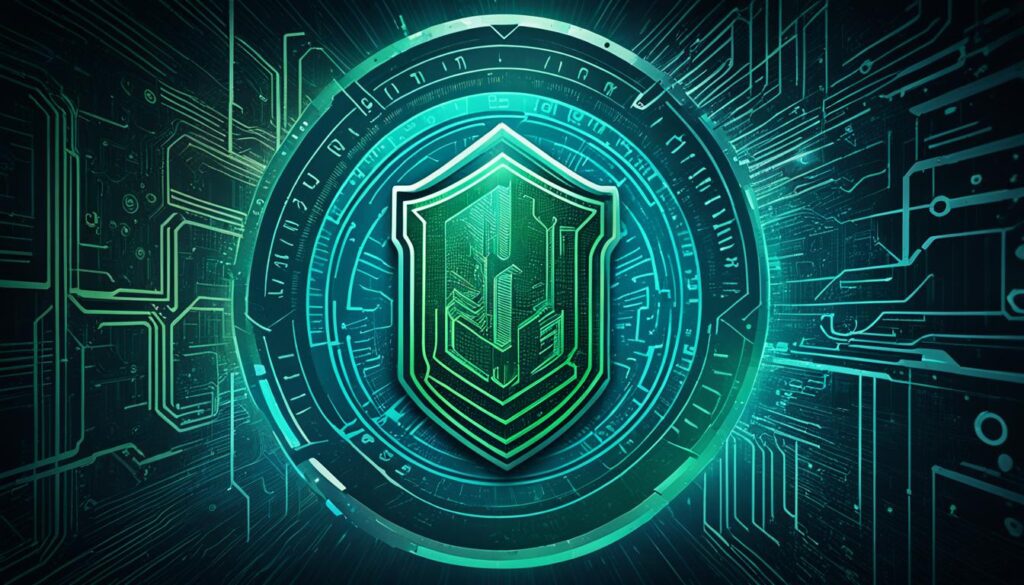In the vast spectrum of internet security, a staggering 97% of all malware is distributed through the web, placing unprecedented emphasis on digital certificate security. Code signing certificates stand as a vital bulwark in this digital battleground, ensuring code integrity and authentication. These powerful tools are not just about keeping software secure; they’re about preserving the very trust that individuals and companies place in the digital infrastructure. As cyber threats grow ever more sophisticated, evidenced by notorious breaches like those at Adobe and ASUS, the importance of code signing becomes ever clearer.
These certificates are the silent guardians of secure software development, pivotal in the fight against hackers who relentlessly seek methods to infiltrate networks and impersonate legitimate developers. The core utility of code signing is in building robust fortifications to safeguard against such infiltrations, ensuring that only the right code is signed and distributed – and only by authorized individuals. The adoption of these certificates is a testament to the industry’s commitment to security, trust, and reliability.
Key Takeaways
- Code signing certificates crucially maintain digital certificate security against malware distribution.
- Ensuring code integrity and authentication is paramount in protecting both software and user trust.
- Secure software development is supported by robust code signing practices which prevent unauthorized access.
- Real-world incidents highlight the necessity for vigilant security measures within developer networks and build servers.
- Authorized personnel must be the sole gatekeepers for code signing to guarantee the legitimacy and safety of software.
Understanding the Fundamentals of Code Signing Certificates
The digital realm hinges on trust, and code signing certificates are the trust anchors that assure both developers and users of the legitimacy and security of software. At the core of this trust, lies the code signing process, a mechanism that binds the identity of the software author to the code itself. This essential service is part of a rigorous certificate authority verification system that guarantees that the code in question has not been tampered with since its original signing.
How Code Signing Works to Secure Software
Digital signatures, backed by code signing certificates, facilitate code integrity and authentication, key elements in a defense against cyber threats. When an executable or script is digitally signed, it undergoes a cryptographic process that creates a one-way hash of the code. The digital certificate, which contains the author’s verified information, is used to encrypt this hash. Upon download or execution, decoding the hash with the public key ensures that if the software has been altered in any way, the hash will not match, and the code will fail verification checks.
Publicly Trusted Certification Authorities: The Role They Play
Central to the code signing process are the publicly trusted certification authorities, which perform stringent identity vetting before issuing certificates. These authorities possess root certificates that are universally trusted and pre-installed in major web browsers and operating systems. A certificate authority verification involves authentically linking the code signing certificate to these trusted roots, rendering a chain of trust that users and devices depend on. The benefits of code signing are manifold, but at their core—they are about establishing undeniable proof of origin and maintaining code integrity.
| Code Signing Certificate Element | Importance | Benefits |
|---|---|---|
| Digital Signature | Ensures that code is authentic and unaltered since signing | Protects users against malware and tampering |
| Certificate Authority | Provides trusted identity verification | Strengthen consumer confidence and software reliability |
| Root Certificates | Anchors the trust chain for device recognition | Seamless software installations with fewer security warnings |
Through a comprehensive grasp of the code signing benefits afforded by trustworthy CAs and rigorous verification processes, software developers can significantly mitigate the risks associated with software distribution, offering their users the peace of mind that comes from a well-secured software environment.
Securing the Software Supply Chain Against Attacks

In the realm of technology, the security of the software supply chain has become a paramount concern. With software supply chain attacks on the rise, it’s essential for organizations involved in secure software development to take preventative action against potential vulnerabilities. These attacks have the potential to compromise the integrity of software systems, leading to significant data breaches and loss of trust from end users.
One of the foundational steps in securing the software supply chain is by embedding security into the development process. It is not just about finding vulnerabilities, but rather establishing a protocol that ensures the safety and resilience of software from conception through dissemination. The vigilant use of code signing certificates is crucial. By properly implementing these certificates, developers can provide a safeguard, validating the authenticity and origin of software, and mitigating the risk of tampering by malicious actors.
- Enforce robust access controls to prevent unauthorized use of code signing tools.
- Implement strict identity verification processes for personnel who have code signing privileges.
- Use automated tools to scan for anomalies in code behavior throughout the development cycle.
- Conduct regular security audits to ensure compliance with industry best practices.
Maintaining stringent security protocols is essential in the fight against software supply chain attacks. Only by cultivating a culture of security and vigilance within the development community can the swift and covert nature of these threats be thwarted. It starts with education and ends with diligence, an ongoing commitment to improving and evolving secure software development practices to outpace those looking to exploit the system for nefarious purposes.
Mitigating Risks with Hardware Security Modules (HSMs)
As cyber threats evolve, protecting digital certificate security becomes increasingly challenging. Hardware Security Modules (HSMs) have emerged as a critical component in defending cryptographic keys from unauthorized access. However, relying solely on HSMs may not suffice in the face of sophisticated cyber-attacks aimed at code signing systems.
The Limitations of HSMs in Preventing Code Signing Breaches
Hardware Security Modules, while instrumental in securing keys used in the digital certification process, are not infallible. Experienced hackers have developed methods to exploit even the most robust HSMs by targeting other vulnerable systems within the infrastructure, such as build servers. This underscores the necessity for a multi-layered approach to security encompassing not just HSMs but a range of supplementary safeguards.
Supplementing HSM Protection with Additional Security Measures
To augment the security provided by Hardware Security Modules, organizations must implement additional protocols and practices. Such measures include defining clear roles for staff who handle critical signing operations, establishing stringent access permissions, and continuously monitoring activity to quickly identify and respond to any unusual actions that could indicate a breach.
| Security Feature | Role in Digital Certificate Security | Integration with HSM |
|---|---|---|
| Multi-factor Authentication | Ensures that only authorized personnel can access HSMs | Primary method of verifying user identity before HSM access |
| Access Control Policies | Limits operations based on user roles and responsibilities | Enables fine-grained control over functions and usage of HSMs |
| Audit and Logging | Tracks all operations to detect and analyze potential security events | Records detailed logs for actions performed on HSMs |
| Regular Key Rotation | Minimizes impact of potential key compromise | HSMs facilitate and enforce scheduled key changes |
Implementing these protocols alongside HSMs creates a comprehensive shield, significantly enhancing the integrity and trustworthiness of a digital certificate security system. Doing so not only hinders attackers attempting to breach HSMs but also preserves the reliability of the entire code signing process against emerging threats.
The Importance of Code Signing Certificates
In the digital age, where software insecurities pose a significant threat to users and companies alike, the role of code signing certificates has grown increasingly vital. Authenticated with digital signatures, these certificates are instrumental in underpinning user trust and ensuring digital signature security. Let’s delve into how they enhance the software distribution landscape.
Enhancing Trust Through Digital Signatures
When a user downloads software, a swift glance at the source might not suffice to gauge its safety. Here, code signing certificates step in, providing assurance that the software is legitimate and the publisher can be trusted. They attach verifiable digital signatures to the software, establishing a digital handshake between the provider and the user. This not only fortifies the overall perception of digital signature security but also serves as a seal of integrity for the code itself.

User Decisions Influenced by Code Authenticity
Users often face the pivotal moment of deciding whether to install software or discard it based on trustworthiness. The presence of a code signing certificate dramatically sways this decision. Equipped with proof that the code has not been tampered with since its signing, a user can confidently proceed with installation. The digital signature stands not just as a marker of authenticity, but a guarantor of the code’s unaltered state since leaving the software provider’s hands.
Below is a comparative chart that illustrates the striking code signing benefits, showcasing how they influence user trust and contribute to digital signature security:
| Aspect of Software Distribution | Without Code Signing Certificate | With Code Signing Certificate |
|---|---|---|
| User Confidence | Low | High |
| Risk of Tampering | High | Low |
| Software Authenticity | Questionable | Verified |
| Installation Decisions | Cautionary | Assured |
| Digital Signature Security | None | Enhanced |
In summary, the integration of code signing certificates is a non-negotiable aspect of distributing credible software. By weaving these certificates into the fabric of software reliability, publishers can ensure that the path from creation to installation is transparent and secure, ultimately fortifying user trust in an ever-evolving digital world.
Implementing Code Signing Best Practices
To ensure the integrity of software development and the distribution process, adopting code signing best practices is crucial. These guidelines are designed not only to protect software from tampering but also to foster trust among users, developers, and stakeholders within the tech industry.
Defining Developer Roles and Duties for Code Signing
Certain roles and responsibilities must be established to facilitate secure software development. Ensuring that developers and operations teams understand these roles helps in maintaining a secure software release pipeline.
- Code Signer: Person responsible for signing the code after thorough validation.
- Code Reviewer: Individual tasked with reviewing code for security and compliance.
- Approval Authority: Designated supervisor who approves code for signing.
Enforcing Strict Code Signing Policies
The establishment and enforcement of strict code signing policies are vital to the defense against unauthorized access and potential misuse of signing keys. These policies should be clear, comprehensive, and strictly enforced.
| Policy Component | Description | Implementation Strategy |
|---|---|---|
| Access Control | Limits code signing capabilities to authorized personnel | Implement multi-factor authentication and role-based access controls |
| Key Management | Secure storage and handling of private keys | Use of Hardware Security Modules (HSMs) and key rotation policies |
| Audit and Compliance | Tracking and recording code signing activities for transparency and accountability | Regular audits and maintaining detailed logs of code signing actions |
| Separation of Environments | Distinct separation between development/testing and production environments | Utilization of separate certificates for different stages of development |
By incorporating these best practices, organizations can greatly enhance their security posture and uphold the principles of secure software development. It is paramount that these practices be revisited regularly, updated in accordance with current security trends, and adhered to by all members of a software development team.
Segregating Certificates for Development and Production
In order to maintain the highest standards of code integrity and security throughout the code signing process, it is critical to implement a clear separation between the certificates used for development and those used for production. This not only reinforces the security of the software during the development stages but also ensures that the certificate authority verification process remains steadfast during production, providing end-users with confidence in the software’s source and security.

The following table illustrates the strategic segregation of certificates that should be adhered to in the code signing process for enhanced security:
| Environment | Purpose | Certificate Type | Root of Trust |
|---|---|---|---|
| Development | Testing and Pre-Release Stages | Development Certificates | Separate Development Root |
| Production | Release and Distribution | Production Certificates | Established Production Root |
By strictly utilizing dedicated development certificates during the test and pre-release stages, and reserving production certificates for release signing, developers can more effectively govern the software lifecycle and prevent the possibility of a compromised development certificate affecting the security of production code. This strategy plays a vital role in the certificate authority verification as it provides an additional layer of confidence and trust for users when installing and using software.
Auditing and Tracking Key Usage
For any organization that deals with software development, the security of code signing processes is non-negotiable. Understanding the principles of tracking signing activities, maintaining code integrity, and ensuring authentication is vital for the protection of software assets. It’s not just about guarding against external threats, but also about establishing a robust system of internal accountability.
Why Monitoring Signing Activities is Crucial for Security
Every digital signature is a promise of trust; a guarantee that the code comes from a credible source and remains untampered. This is why monitoring the activities associated with code signing is paramount. It creates a controlled environment by documenting who signed what, when, and under what context. This vigilance is key to both detecting anomalies and deterring potential breaches.
Tracking Techniques to Ensure Code Integrity
Employing sophisticated tracking techniques can take the security of software to the next level by bolstering the authentication process. These techniques include a variety of measures from simple log maintenance to advanced real-time surveillance. The table below outlines key tracking methods and their impact on ensuring code integrity:
| Tracking Method | Purpose | Impact on Code Integrity |
|---|---|---|
| Log Management | To record every instance of code signing for future audit and analysis. | Creates a historical record that can be reviewed to trace any unauthorized changes. |
| Real-Time Surveillance | Provides immediate alerts to any signing activities, allowing for swift actionable insights. | Positively impacts early detection of suspicious behavior, safeguarding code integrity. |
| Access Control | Limits key usage to authorized individuals and processes only. | Prevents unauthorized code modifications and protects against exploitation. |
| Regular Audits | Periodic review of log files and signing activities for any anomalies or policy violations. | Reinforces the reliability of code and adherence to organizational security policies. |
To sum it up, the integrity of code is a direct result of meticulous tracking and auditing of signing activities. By employing these techniques effectively, organizations can not only prevent illicit access and tampering but also cultivate a culture of transparency and trustworthiness in the software development lifecycle.
The Process of Digitally Signing Your Code
As a software developer or publisher, taking the step to digitally sign code is an essential practice that increases the security and integrity of your applications. With the complexity of today’s digital ecosystem, utilizing the right signing tools tailored to various development platforms is fundamental. Whether you’re working with AdobeAIR, utilizing the flexibility of Apple OS X, programming in the versatile Java environment, or requiring the robust Microsoft Authenticode for Windows-based applications, adopting the proper procedure is key to your software’s successful distribution and reception.
Tools and Procedures for Various Development Platforms
Different platforms have distinctive tools and procedures designed to align with the technologies they support. Signing code on these platforms often involves specific command-line utilities or integrated development environment (IDE) options that incorporate code signing seamlessly into the software build process. From game development with AdobeAIR to creating comprehensive desktop applications for Apple OS X, each environment provides a secure method to digitally sign code and ensure its unaltered state from the point of signing to end-user installation.
AdobeAIR, Apple OS X, Java, and Microsoft Authenticode Examples
For example, developers utilizing AdobeAIR may use the AIR Developer Tool (ADT) signing capabilities to package and distribute their applications securely. Meanwhile, on Apple OS X, codesign is a versatile tool not only for signing applications but also for creating installer packages and even checking the signature of existing apps. Java developers benefit from tools like jarsigner for signing and verifying Java Archive (JAR) files, while Microsoft Authenticode offers a trusted signing framework for Windows applications, using tools such as signtool.exe, integrated with Visual Studio and other Microsoft development environments.

To illustrate the varied landscape of code signing tools across platforms, consider the following table highlighting some of the primary tools and their respective operating environments:
| Platform | Code Signing Tool | Function |
|---|---|---|
| AdobeAIR | AIR Developer Tool (ADT) | Package and sign AIR applications |
| Apple OS X | codesign | Sign apps, create installer packages |
| Java | jarsigner | Sign and verify JAR files |
| Microsoft Windows | signtool.exe | Sign Windows applications and drivers |
Regardless of the development platform, the end goal remains the same: to authenticate the source and ensure code integrity. The assurance that code has been digitally signed by a verifiable publisher provides users with the confidence to install and run software they can trust.
Navigating the Assurance of Code Installation
The integrity of software distribution is fortified by the application of code signing certificates, which are pivotal in instilling user trust and guiding code installation decisions. As users embark on the process of installing new software, they are often greeted with security prompts that can either reinforce confidence or trigger skepticism. How these security messages are interpreted can significantly affect their willingness to proceed with an installation.
Understanding Code Verification Security Messaging
During software installation, users encounter security messages that inform them about the source and safety of the application they are about to install. These messages are a direct reflection of the assurance provided by code signing certificates. More than just a routine step, the verification messages convey the legitimacy of the digital signature and affirm that the software has not been tampered with post-signing. Clear and informative messages can be the difference between acceptance and rejection of new software.
User Decision-making in the Trust of Code
At the crux of the installation process is the user’s ability to trust. By providing transparency through code verification security messages, software publishers empower users to make informed decisions with confidence. It’s within these critical moments that user trust, essential for any software publisher’s reputation, is either cemented or eroded. Users rely on explicit, recognizable indicators of security to ensure they are making the right decision for their digital safety.
| Code Verification Indicator | Description | User Perceived Trust Level |
|---|---|---|
| Digital Signature Present | Software digitally signed with a valid certificate | High |
| Security Warning Displayed | Message indicating potential risk | Moderate to Low |
| Publisher Identity | Certified publisher identified within the message | Very High |
| Certificate Authority (CA) | Name of the trusted CA is visible | High |
| Expiration Warning | Notification that the certificate is near or past its expiration date | Low to Very Low |
Certificate Authority Verification and its Impact on Security
The digital world spins on an axis of trust, with certificate authority verification serving as the crux for security measures across the globe. This fundamental process determines the veracity of digital signatures, enabling software applications to parade their integrity with confidence. In an age where cyber threats lurk behind every byte, robust verification tactics are essential for maintaining a secure and trustworthy online environment.

Certificate authority verification, a cornerstone of modern cybersecurity, underpins the effort to establish trust between software publishers and users. By validating the origin of digital certificates, CAs play a pivotal role in ensuring that the software being installed has not been compromised or altered.
Establishing Trust with Root Certificates
The chain of trust begins with root certificates, which are akin to digital passports issued by trusted entities. These certificates are meticulously verified and safeguarded, with their integrity serving as a testament to the authenticity of the publisher. Let’s not underestimate the power of these silent sentinels in affirming a software’s lineage, for they command the universal respect needed to engender user confidence.
How Certificates Prevent Tampering and Establish Authenticity
The prevention of tampering is an essential chapter in the code signing saga. By attaching a signature to code, a certificate attests that the contents have not been meddled with since the time of signing. Verification checks serve as a barrier, rebuffing any form of code degradation or unauthorized meddling. This vigilance in establishing authenticity attributes to an environment where software can be traded and used without succumbing to the shadows of doubt.
Application Reputation and the Role of EV Certificates
In the landscape of software security, application reputation stands as a paramount concern for developers and organizations aiming to convey reliability and establish user trust. This is where Extended Validation (EV) certificates come into play, serving as a significant asset for endorsing developer credibility and supporting a secure digital environment.
The Benefits of Extended Validation for Developer Credibility
Extended Validation certificates undergo a rigorous verification process, which is much more extensive than that for standard certificates. This process involves a thorough examination of the requesting entity’s legal, operational, and physical existence. By meeting the high standards set for EV certificates, developers not only reinforce the security of their applications but also solidify their reputation as trustworthy publishers. Users and platforms alike tend to grant applications signed with EV certificates a higher level of trust, thereby enhancing the overall developer credibility.
Building a Positive Security Perception Among Users
The utilization of EV certificates can have a profound impact on how users perceive the security of an application. A positive perception is crucial, as it directly influences the user’s willingness to download and install software. With fewer security warnings and a clear indication of a verified publisher, users are more inclined to trust that the application has not been tampered with and is safe for use. Therefore, EV certificates serve as an indispensable tool in building a positive security perception among users, promoting a greater sense of security and fostering confidence in the application’s integrity.
Conclusion
The integrity and trust of the software we use daily hinge significantly on the use of code signing certificates. In the realm of digital security, their role is monumental, serving as the gatekeepers that vet and validate the origins and untampered state of applications and software. This authentication process is a cornerstone of secure software development, deterring malicious tampering and fortifying the credibility of software providers. By incorporating these certificates within a broader security framework, developers not only align with the industry’s best practices but also actively engage in shaping a safer digital environment for all users.
Incorporating code signing certificates into the development cycle is an uncompromising step toward establishing and maintaining a resilient application reputation. Not only do they prevent unauthorized modifications to code but they also go a long way in endorsing the authenticity of digital entities. These measures, when seamlessly integrated into security policies and combined with diligent validation practices, multiply the defensive layers against cyber threats. The importance of code signing certificates is underscored by the peace of mind they supply to users, who rely on the security of the applications to navigate the digital space safely.
Ultimately, as we advance in technology and its ubiquity, the imperative for secure software development magnifies. Developers and organizations must remain vigilant, adopting code signing certificates and associated stringent security protocols to protect against the ever-evolving landscape of cyber risks. The collaborative efforts between developers, certificate authorities, and users in maintaining a secure digital infrastructure are vital for continuing to derive value from our connected world without compromising on trust and safety.
FAQ
What is the role of code signing certificates in digital certificate security?
Code signing certificates are crucial for establishing digital certificate security. They ensure code integrity and authenticate the source of the software, which protects against unauthorized modifications and verifies the identity of software publishers.
How does the code signing process work to secure software?
The code signing process involves using a digital signature to sign executables and scripts. This confirms the identity of the software author and guarantees the code has not been altered after the signing process, thereby securing the software from being compromised.
What role do publicly trusted certification authorities play in code signing?
Publicly trusted certification authorities authenticate the identities of entities requesting code signing certificates and issue certificates that link to trusted root certificates. This helps web browsers and operating systems recognize and trust digitally signed code, facilitating the certificate authority verification process.
How does secure software development protect against software supply chain attacks?
Secure software development practices, including the proper implementation of code signing certificates, create security barriers. These practices help prevent unauthorized access to code signing tools, which can mitigate the risks associated with software supply chain attacks.
What are the limitations of Hardware Security Modules (HSMs) in preventing code signing breaches?
HSMs are effective in protecting private keys used for code signing but cannot prevent all breaches, such as those targeting build servers. Hackers may request signatures for malicious code, which necessitates additional security measures alongside HSMs to provide comprehensive protection.
Why is it beneficial to enhance trust through digital signatures?
Digital signatures provide users with assurance of the software provider’s identity and the authenticity of the code. It’s a critical factor in a user’s decision to install software, as it helps them trust that the software is secure and has not been tampered with.
What are some code signing best practices for developers?
Code signing best practices include clearly defining developer roles, segregating test and production keys, enforcing strict signing policies, and establishing rigorous access controls to maintain the integrity and security of the code signing process.
Why is segregating certificates for development and production essential?
Segregating certificates for development and production prevents the potential for misuse of development keys in a production environment and ensures that only the intended code is signed with the appropriate level of trust tied to each stage.
Why is monitoring signing activities crucial for security?
Monitoring signing activities helps establish accountability, ensures that only authorized individuals access the signing keys, and can detect unauthorized or malicious activities early on, thus protecting the integrity of the software being produced.
What are some tracking techniques used to ensure code integrity?
Techniques like maintaining detailed logs of key usage and employing real-time surveillance of code signing activities help ensure that the code’s integrity is preserved by monitoring for any unauthorized changes or access.
How do various development platforms handle the process of digitally signing code?
Development platforms typically offer specific tools and procedures for signing code. For instance, AdobeAIR, Apple OS X, Java, and Microsoft Authenticode each have specialized methods and tools designed to integrate digital signatures into their respective software packages effectively.
How do code verification security messages influence user decisions?
Code verification security messages during installation inform users about the security status of the software, such as details about the digital certificate and publisher. Understanding these messages helps users decide whether to trust and install the software.
What is the impact of certificate authority verification on security?
Certificate authority verification strengthens security by ensuring that a code signing certificate is issued by a trusted CA. This process includes checking the certificate against revocation lists, thereby establishing trust and preventing tampering.
How do Extended Validation (EV) certificates enhance a developer’s credibility and application reputation?
EV certificates undergo a more rigorous vetting process and are therefore seen as more trustworthy. They can reduce security warnings, elevate user confidence, and enhance the reputation of the application and the credibility of the developer by asserting a higher standard of security.





